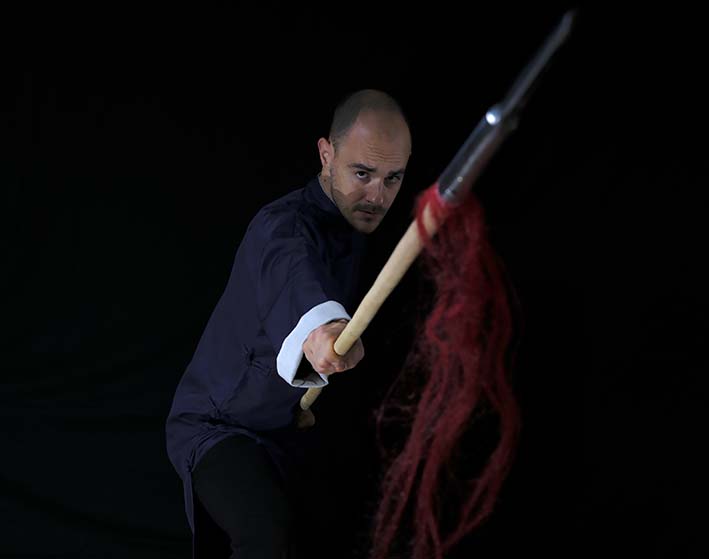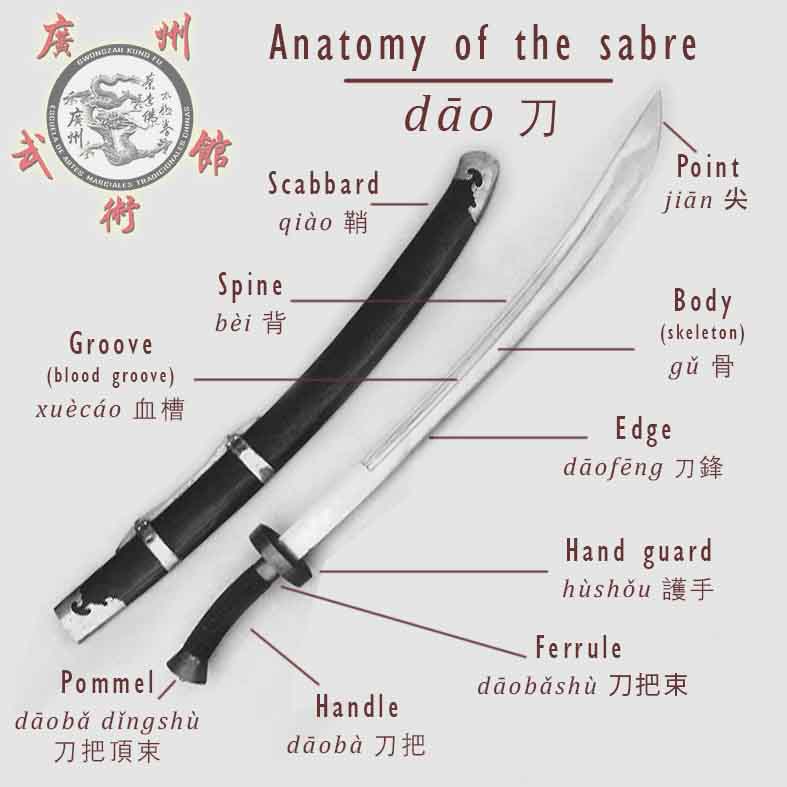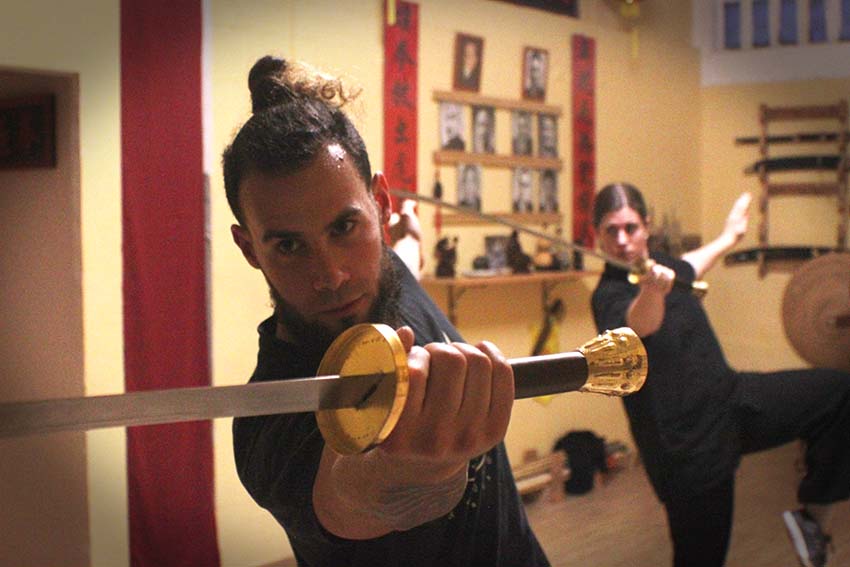Introduction
Weapons training is an indispensable part of any traditional Kungfu style. This training not only includes movements or aesthetic sequences, no matter how much martial spirit they have, but also must contain the necessary knowledge to apply the techniques of each weapon in combat.
Therefore, the study of weapons in kungfu must include a series of specific learning fields, such as: the characteristics and anatomy of the weapon, its mechanics, the anatomical targets to which the attacks are directed, strategies and guard positions, the forms or sequences belonging to the style, solo and two-person exercises or combinations, and sparring, in addition to, of course, the technical corpus of the weapon itself.

Warning
The study of traditional kungfu weapons has nothing to do with promoting violence. On the contrary, these are arts focused on self-development, discipline and self-mastery.
Only students who have demonstrated ethical, humble and peaceful conduct, and a calm mind, are instructed in the actual use of martial arts, the main purpose of which is self-protection.
In addition, the study of traditional weapons involves a high level of discipline and concentration. Students should develop a high level of self-control both physically and mentally, as well as a heightened awareness of the consequences of violence. A well-trained martial artist is actually less dangerous than an untrained one, because he or she is perfectly aware of the consequences of his actions and has the control and ability to regulate them.
In short, the study of traditional kungfu weapons has nothing to do with violence, but rather with personal development and the cultivation of ethical values. By promoting self-defense, discipline and self-control, kungfu teaches us to channel our energies positively and constructively, and to be more balanced and aware in all aspects of life.
As we see, the study of weapons is a broad and deep field. The learning of weapon forms, by itself, contributes little to the study of weapon fighting, as long as it is not accompanied by relevant learning in the other areas mentioned.
Next, we will dwell a little more on each of these points.
Characteristics of the weapon
The first thing the student needs to know is the weapon in question. Knowledge of this weapon includes characteristics such as length, weight, anatomy of the weapon, location of its centre of gravity (or weight balance) and its centre of percussion.
These characteristics will condition the mechanics of the weapon, that is, the way it is handled. The same type of techniques are not used with a weapon whose centre of gravity is closer to the tip than with a weapon with a centre of gravity close to the grip. If it is a blade weapon, in the first case its optimal use will be in the slash, and in the second case, in the thrust.
It is also important to know the percussion centre of the weapon, which is the point at which an impact will provide greater stability to the grip.
On the other hand, the length of the weapon will condition the strategies to be used against other weapons, and the distances at which one is safe or not with respect to an armed opponent.

Anatomy of the Kungfu broadsword.
In addition to knowing the structure of the weapon, it will be necessary to know its length,
weight, center of gravity, etc.
Weapon mechanics
As already mentioned, the mechanics of the weapon is conditioned by its characteristics. Obviously, a blunt weapon is not the same as a sharp weapon, a long weapon than a short weapon, a flexible weapon than a rigid weapon, etc. The characteristics and mechanics of the weapon will in turn condition the anatomical objectives to which the attacks are directed, or the way to stop and block an enemy weapon.
Attention must be paid to how power is generated with that weapon and how the different joints of the body align with it, especially the wrists. In short, it is about turning the weapon into an extension of the body itself.
With a blade weapon, in addition, special attention will have to be paid to how the blade aligns with the direction of movement, so that the weapon penetrates effectively and does not get stuck in the opponent's body.
Anatomical targets
Anatomical targets are the parts of the human body to which the weapon's attacks are ideally directed, so that they are efficient.
These targets may vary depending on the weapon used. For example, a blunt weapon like a long staff is not the same as a blade weapon. In the first case, the attacks will normally be directed at bones and joints, in order to break them, while in the second case they can be directed to cut muscles or tendons or to cut entire limbs, including bone, depending on the characteristics and mechanics of the weapon.
A two-handed blade is much more efficient at cutting bone than a single-handed blade weapon. In turn, a weapon specialized in the slash will have more chances of cutting a limb than a thrusting weapon, such as the Chinese straight sword, which lacks cutting power and, therefore, will be stuck in the bone more easily. All these conditions influence the choice of anatomical targets.
For blade weapons, these targets usually include the wrist of the lead hand, the thigh of the front leg (usually above the knee), the neck, belly, groin, or femoral artery, and may also include the armpit or tendons behind the knee (hamstring).
On the other hand, with a blunt weapon, such as a long staff, the anatomical structures to which the attacks are directed are different, and will include, in addition to the front hand, the knee joint, sternum, ribs or skull.
Perhaps a special case is the Kungfu fan, in which anatomical targets may be smaller, more precise, or subtle, such as the throat, temple, eyes, jaw, groin, and other pressure points (acupuncture points).

Continuing with the example of the sabre, the graph above shows the main anatomical targets.
Technical corpus
Of course, learning always includes the technical body of each weapon. This knowledge usually comprises the essential part of training. However, none of the other fields of study should be overlooked, since the technique itself will not be effective if we do not know where to direct it, or the strategies to use to get impact on the opponent.
The learning of this technical body includes both the performance of isolated techniques, solo combinations, practice with training devices, or training of weapon forms or sequences.
Strategies
The strategies to be used in weapon combat depend not only on the weapon one carries, but also on the opponent's weapon. These strategies include guard positions, how to position oneself to protect one's body, or how to attack, defend, and counterattack. A part of this knowledge is extrapolated from the empty-hand knowledge of a particular style, with some nuances or particularities.

Applications and sparring
Finally, in the study of the weapon, two-person application exercises should be included, progressing from a more fixed or agreed way to an increasingly free application, in order to end with sparring.
Conclusions
Learning Kungfu weapons is a deep field of study. Unfortunately, this is often overlooked, and many schools or instructors limit their teaching to just forms, believing that these are sufficient to acquire a knowledge of the weapon, which is a very serious mistake.
There is nothing wrong with learning only forms, if there is no martial interest in the practitioner, as long as one is aware of the limitations that this entails. What, in our eyes, is not congruent in the study of Kungfu, is to pretend to master many weapons only through the practice of forms, when one does not have a deep knowledge of the most basic weapons.
In our school we try to take the student, progressively, through each of these fields of study, so that he or she acquires a deep and not superfluous knowledge. This learning, like any other field within traditional Kungfu, requires years of study and a commitment to perseverance and dedication.
Although the road is undoubtedly arduous, it is both very rewarding and worth traveling, and brings us many benefits that go beyond martial knowledge. Kungfu is a very valuable tradition to whose maintenance we must dedicate ourselves body and soul, so that the knowledge bequeathed by the old masters is not lost, and future generations can also benefit from it.

2 thoughts on “Fundamentals of the Study of Weapons in Kungfu”
Do you also teach archery and other weapons? How much to live and train there per month in USD?
Hi Nadine,
We replied via email already but just to say it here: we do not teach archery but we do teach other weapons, mostly long staff, spear, broadsword, straigth double-edged sword (jiàn), butterfly swords, fan, and so on.